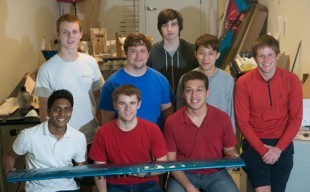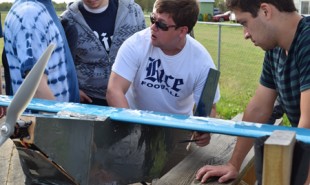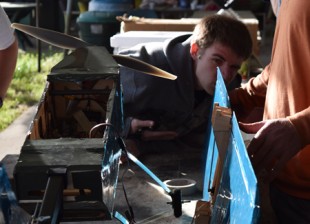David Ruth
713-348-6327
david@rice.edu
Jade Boyd
713-348-6778
jadeboyd@rice.edu
Runway Boys fly where no Owls have gone before
Team’s long hours pay off in Arizona and at Rice’s Engineering Design Showcase
HOUSTON — (April 21, 2015) — In an age of routine air travel, drone aircraft and robotic pilots, it’s easy to forget that aviation is difficult and unforgiving. Runway Boys, five Rice University seniors who spent more than 2,000 hours creating a remote-controlled airplane to compete in the world’s premier collegiate aerospace engineering contest, had a daily reminder for the past eight months.
“This is a huge optimization problem,” team member Cory Black said just before the team’s third and final test flight at an airfield south of Houston in Alvin, Texas. “If we only had to worry about one thing, it would be different, but we need to fly three missions with very different parameters.”
Black and teammates Leon Chen, Sam de la Torre, Ryan McKnight and Matt Lord, all mechanical engineering majors, built their plane for the American Institute of Aeronautics and Astronautics’ annual Design/Build/Fly competition April 10-12 in Tucson, Ariz. The contest was limited to fewer than 100 teams from the world’s top aerospace engineering programs. No Rice team had ever competed, and Runway Boys finished with distinction: They got 29th place and were one of only 23 teams to complete all three flight missions. The team also captured the $500 award for best aerospace or transportation technology in Rice’s annual Engineering Design Showcase April 16.

Runway Boys included (clockwise from right) Martel College senior Matt Lord, Brown College senior Sam de la Torre, McMurtry College senior Ryan McKnight, McMurtry College junior Nuwan Herath, Sid Richardson College sophomore Blake Bourne, McMurtry College senior Cory Black, Sid Richardson College sophomore Justin Daily and McMurtry College senior Leon Chen.
From the outset, Runway Boys felt deadline pressure. Though the project was assigned at the beginning of the fall semester, the team determined they would need to build and test three prototypes to be competitive in Tucson.
“There were teams from Israel, Turkey, China, Japan and all across the U.S.,” de la Torre said. “MIT has a budget of $25,000 for this each year. And the U.S. Air Force Academy and the Turkish Air Force Academy were there.”
The contest rules also required that underclassmen participate. So the five seniors recruited 13 younger teammates and led smaller groups that focused on subsystems like airframe, avionics and propulsion. The five also set and met an ambitious schedule to build and fly their first prototype before the end of the fall semester.
The final version of the airplane had a balsa and spruce frame covered with Mylar film. It weighed about five pounds and was designed to perform in a speed test, a cargo-carrying flight and a cargo airdrop mission. To level the playing field among all teams, contest rules specified the type and weight of batteries that could be used based on the size of the airplane’s propeller.
Teams received a certain number of points for each test flight. No points were awarded if the plane crashed during the flight. More points were awarded for successive flights, so the more flights teams could complete without crashing their plane, the higher the stakes.
In the second flight, the plane was required to carry a five-pound weight and take off in a mere 60 feet. For the final flight, the plane needed to drop plastic balls within a target zone on the ground, and points would only be awarded if one ball was dropped per lap.
Knowing they would be required to work with a certified pilot at the Tucson competition, the team chose to conduct all test flights with an experienced pilot, Tim Haskins of the Alvin R/C Model Airplane Association.
“In the first test, he flew our plane for about two minutes and gave us feedback,” Lord said. “The plane wasn’t very easy to control, and we also learned the landing gear was the weakest component. It failed during the first landing.”

Cory Black (center) and Sam de la Torre (right) make adjustments before the ill-fated cargo test flight March 29.
In fact, the Runway Boys had a significant failure during each of their three flight test sessions. They got in four flights the second time, but the batteries caused a fire before they could try the weight test. The weighted flight proved fatal in the third test session. The weight played havoc with stability and led to a crash before takeoff that sheered away the nose of the plane.
“The challenge came down to optimizing the tradeoffs between the different configurations,” Lord said. “For example, structural stability is key to landing safely with the weight, but every ounce counts because the scores are multiplied by modifier based upon the overall weight of the aircraft. The lighter the airplane, the higher the multiplier.”
The team’s hard work paid off in Tucson. Runway Boys finished ahead of most of the other teams on the speed test. On the crucial cargo flight, their modified controls allowed the plane to clear the runway with inches to spare, and the redesigned landing gear took the weight. They also dropped all four plastic balls on target. In the end, Runway Boys finished all three missions without a crash — which 70 percent of the competitors were unable to do.
“We fared very well in the flight missions, but we were really hurt by our rated aircraft score, which scaled our score down quite a bit,” Lord said. “Overall, we were extremely happy with how we did since this was the first team from Rice to ever attend. And we also learned a lot of important lessons for the younger members of the team who plan to go back next year.”
-30-
VIDEO is available at:
https://youtu.be/vn2vg_5crEQ
High-resolution IMAGES are available for download at:
https://news2.rice.edu/files/2015/04/0420_RUNWAY-group-lg.jpg
CAPTION: Runway Boys included (clockwise from right) Martel College senior Matt Lord, Brown College senior Sam de la Torre, McMurtry College senior Ryan McKnight, McMurtry College junior Nuwan Herath, Sid Richardson College sophomore Blake Bourne, McMurtry College senior Cory Black, Sid Richardson College sophomore Justin Daily and McMurtry College senior Leon Chen.
CREDIT: Jeff Fitlow/Rice University
https://news2.rice.edu/files/2015/04/0420_RUNWAY-RyanWing-lg.jpg
CAPTION: Ryan McKnight checks a control-surface adjustment before a March 29 test flight.
CREDIT: Jade Boyd/Rice University
https://news2.rice.edu/files/2015/04/0420_RUNWAY-Corey-lg.jpg
CAPTION: Cory Black (center) and Sam de la Torre (right) make adjustments before the ill-fated cargo test flight March 29.
CREDIT: Jade Boyd/Rice University
More information about the competition is available at:
http://oedk.rice.edu/Sys/PublicProfile/25530219/3636717
https://twitter.com/hashtag/AiaaDBF?src=hash
Located on a 300-acre forested campus in Houston, Rice University is consistently ranked among the nation’s top 20 universities by U.S. News & World Report. Rice has highly respected schools of Architecture, Business, Continuing Studies, Engineering, Humanities, Music, Natural Sciences and Social Sciences and is home to the Baker Institute for Public Policy. With 3,888 undergraduates and 2,610 graduate students, Rice’s undergraduate student-to-faculty ratio is just over 6-to-1. Its residential college system builds close-knit communities and lifelong friendships, just one reason why Rice is highly ranked for best quality of life by the Princeton Review and for best value among private universities by Kiplinger’s Personal Finance. To read “What they’re saying about Rice,” go here.


